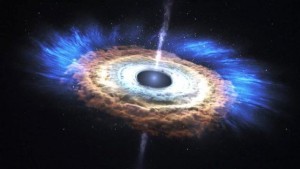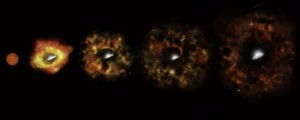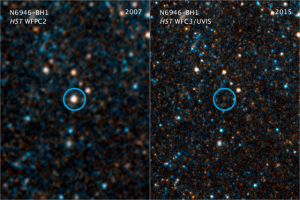The star N6946-BH1 in a spiral formation 22 million light years away known as the ‘fireworks galaxy’, was last seen by Nasa’s Hubble Telescope in 2009. By 2015, it wasn’t there anymore.
How did a star 25 times the size of our Sun simply wink out of existence? Such large stars often go out with a bang – a supernova – blasting off much of their remaining mass before collapsing to form an incredibly dense black hole.
But this didn’t happen to N6946-BH1, according to a paper published in the Monthly Notices of the Royal Astronomical Society. There was a slight brightening around 2009 where the star expelled its outer layer in a gentle puff, but it wasn’t anywhere near bright enough to be a supernova.
The Hubble Telescope and the Spitzer Space Telescope were not able to detect the star when they looked with the same filters at this patch of space in 2015. One theory for what happened to it is that it formed a black hole directly without going through the usual process of a supernova first.
“The typical view is that a star can form a black hole only after it goes supernova,” said Christopher Kochanek of Ohio State University in a statement.
Although this contradicts current theories of the role of supernovas in forming black holes, it may be much more common than astronomers previously thought.
“If a star can fall short of a supernova and still make a black hole, that would help to explain why we don’t see supernovae from the most massive stars.”
As such, the findings could shed light on the origin of supermassive black holes. Up to 30% of massive stars capable of a supernova could instead collapse to become a black hole without an explosion. Astronomers have dubbed this process a “massive fail”.
“N6946-BH1 is the only likely failed supernova that we found in the first seven years of our survey. During this period, six normal supernovae have occurred within the galaxies we’ve been monitoring, suggesting that 10 to 30% of massive stars die as failed supernovae,” said Scott Adams, a former Ohio State student.
However, another theory for what happened to the star is that it is in fact still there, shrouded in a cloud of gas. The miniature explosion noted in 2009 could have created a cloud that would hide it from instruments on Earth.
But very little infra-red radiation was seen from the site where the star was. At least some radiation would be expected to seep through if N6946-BH1 was hiding behind a cloud.
Further observation of this region of space with Nasa’s Chandra X-ray Observatory could help to elucidate whether the star is really still there or not.
Ask me anything
Explore related questions








